The Intel Core i9-10900K, a former flagship processor, remains a potent CPU for high-performance computing and gaming tasks. To unlock its full potential, pairing it with a capable motherboard is essential. This guide provides a detailed, purely informational overview of the top motherboard options originally released for this processor, offering an objective analysis based on their status and features.
Given that the i9-10900K was launched in 2020, most of the premier motherboards designed for its LGA 1200 socket are now discontinued by manufacturers. This article will not only detail these specific boards but also provide crucial context on their availability and what to consider if you are building or maintaining a system around this CPU today.
The Intel i9-10900K in 2025: Still a Contender?
With 10 cores, 20 threads, and a boost clock of up to 5.3 GHz, the i9-10900K still delivers impressive performance that can handle modern games and demanding applications. For users who already own this CPU, building a system around it can be a cost-effective way to achieve high-end performance. However, for those building a new PC from scratch, it’s important to weigh the ecosystem’s age against current-generation alternatives. The challenge often lies not with the CPU’s power but in sourcing new, high-quality components like motherboards. If you’re wondering when you should upgrade your motherboard, platform age and component availability are key factors.
Comparison of Top Motherboards for the i9-10900K
This table provides a high-level overview of the key specifications for the eight motherboards detailed in this guide. Note that all these models are officially discontinued, so availability is limited to remaining new stock or the used market.
| Feature | MSI MPG Z590 Gaming Force | ASUS ROG Maximus XII Hero Z490 | MSI MEG Z590 Unify-X | ASUS ROG Strix Z490-G Gaming | ASUS ROG Strix Z490-I Gaming | MSI MEG Z490 ACE | GIGABYTE Z490 Vision D | GIGABYTE Z490 AORUS Xtreme |
| Chipset | Intel Z590 | Intel Z490 | Intel Z590 | Intel Z490 | Intel Z490 | Intel Z490 | Intel Z490 | Intel Z490 |
| Form Factor | ATX | ATX | ATX | Micro-ATX | Mini-ITX | ATX | ATX | E-ATX |
| VRM | 16+1+1 Phases | 14+2 Phases | 16+2 Phases | 12+2 Phases | 8+2 Phases | 16+1 Phases | 12+1 Phases | 16+1 Phases |
| Max RAM (OC) | 5333MHz | 4800MHz | 5600MHz | 4600MHz | 4800MHz | 5000MHz | 5000MHz | 5000MHz |
| M.2 Slots | 3 | 3 | 4 | 2 | 2 | 3 | 3 | 3 |
| SATA Ports | 6 | 6 | 6 | 6 | 4 | 6 | 6 | 6 |
| PCIe x16 (Gen) | 1x 4.0/3.0, 2x 3.0 | 3x 3.0 | 1x 4.0/3.0, 1x 3.0 | 2x 3.0 | 1x 3.0 | 3x 3.0 | 3x 3.0 | 3x 3.0 |
| Networking | 2.5GbE LAN, Wi-Fi 6E | 5GbE + 1GbE LAN, Wi-Fi 6 | 2.5GbE LAN, Wi-Fi 6E | 2.5GbE LAN, Wi-Fi 6 | 2.5GbE LAN, Wi-Fi 6 | 2.5GbE LAN, Wi-Fi 6 | 2x 1GbE LAN, Wi-Fi 6 | 10GbE + 2.5GbE LAN, Wi-Fi 6 |
| Rear USB-C | 1x USB 3.2 Gen 2×2 | 1x USB 3.2 Gen 2 | 1x USB 3.2 Gen 2×2 | 1x USB 3.2 Gen 2 | 1x USB 3.2 Gen 2 | 1x USB 3.2 Gen 2×2 | 2x Thunderbolt 3 | 2x Thunderbolt 3 |
| Status | Discontinued | Discontinued | Discontinued | Discontinued | Discontinued | Discontinued | Discontinued | Discontinued |
Blockquote: When pairing a 10th Gen CPU like the i9-10900K with a Z590 motherboard, the primary PCIe x16 slot and the CPU-connected M.2 slot will operate at PCIe 3.0 speeds. The PCIe 4.0 functionality of Z590 boards is only enabled when using an 11th Gen Intel CPU.
Detailed Analysis of 8 Motherboards for the i9-10900K
This section provides an objective look at each of the eight specified motherboards. The focus is on their original design intent and key features to help you understand their value proposition in today’s market.
1. MSI MPG Z590 Gaming Force
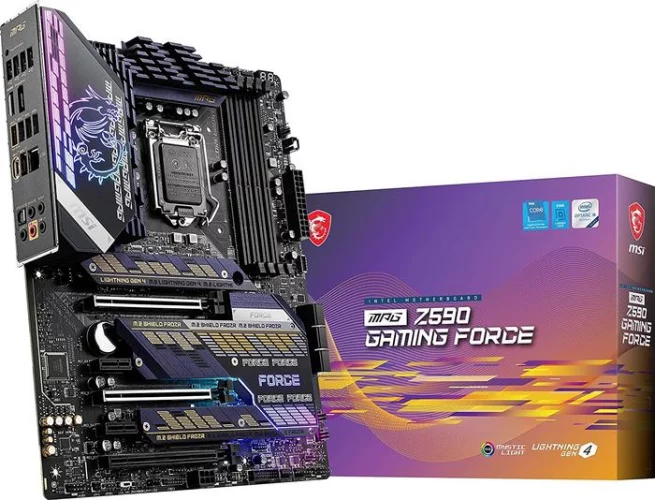
Key Specifications
- Chipset: Intel Z590
- Form Factor: ATX
- VRM: 16+1+1 Duet Rail Power System (60A)
- Memory: 4x DIMM, up to 128GB DDR4-5333 (OC)
- Storage: 3x M.2 slots, 6x SATA 6Gb/s ports
- Networking: Intel I225-V 2.5GbE LAN, Intel Wi-Fi 6E AX210
- Audio: Realtek ALC4080 Codec
Objective Analysis
The MSI MPG Z590 Gaming Force was designed as a high-performance motherboard for gamers and enthusiasts. Its robust 16-phase VRM is more than capable of handling the power demands of an overclocked i9-10900K. The board features an extensive cooling solution, including large heatsinks for the VRM, chipset, and M.2 slots. Its inclusion of Wi-Fi 6E and a 2.5GbE LAN port made it a forward-looking choice at the time of its release. Aesthetically, its aggressive design and Mystic Light RGB integration appealed to users building visually striking systems, such as those housed in the best airflow PC cases.
Status & Alternatives
- Status: Discontinued.
- Alternatives: Finding this specific model new is highly unlikely. Users should search on second-hand marketplaces. If building a new system today, a modern equivalent would be a mid-to-high-range Z790 motherboard paired with a current-generation Intel Core processor, which would offer features like DDR5 and PCIe 5.0 support.
2. ASUS ROG Maximus XII Hero (Wi-Fi) Z490
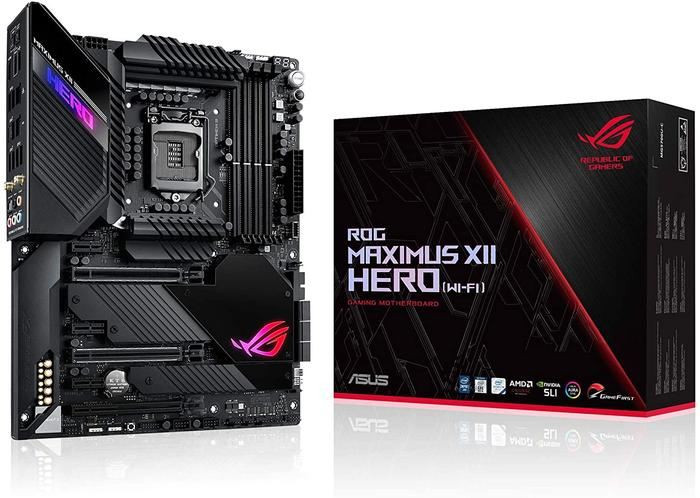
Key Specifications
- Chipset: Intel Z490
- Form Factor: ATX
- VRM: 14+2 Power Stages (60A)
- Memory: 4x DIMM, up to 128GB DDR4-4800 (OC)
- Storage: 3x M.2 slots, 6x SATA 6Gb/s ports
- Networking: Marvell AQtion 5GbE, Intel I219-V 1GbE, Intel Wi-Fi 6 AX201
- Audio: ROG SupremeFX S1220 Codec
Objective Analysis
The ROG Maximus XII Hero was a premium offering in the Z490 lineup, built for serious enthusiasts who demand robust power delivery, extensive cooling options, and a rich feature set. Its 14+2 power stage design is well-suited for pushing the i9-10900K to its limits. A standout feature is its dual LAN setup, including a fast 5GbE port, which was a luxury at the time. The board is packed with ROG-exclusive features like AI Overclocking and AI Cooling, providing intelligent system tuning. It represents a classic example of why a good motherboard is important for gaming.
Status & Alternatives
- Status: Discontinued.
- Alternatives: As a popular high-end board, the Maximus XII Hero may appear on used markets, but often at a premium. A contemporary alternative would be an ASUS ROG Strix or Maximus series Z790 motherboard, which continues the legacy of providing enthusiast-grade features for the latest Intel CPUs.
3. MSI MEG Z590 Unify-X
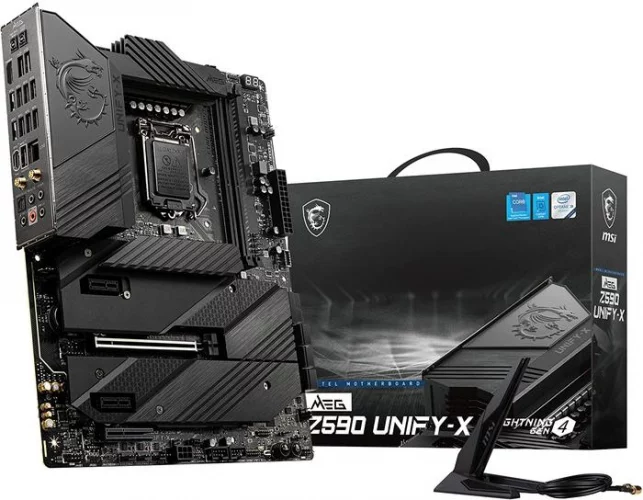
Key Specifications
- Chipset: Intel Z590
- Form Factor: ATX
- VRM: 16+2+1 Direct Power Design (90A)
- Memory: 2x DIMM, up to 64GB DDR4-5600+ (OC)
- Storage: 4x M.2 slots, 6x SATA 6Gb/s ports
- Networking: Intel I225-V 2.5GbE LAN, Intel Wi-Fi 6E AX210
- Audio: Realtek ALC4080 Codec
Objective Analysis
The MSI MEG Z590 Unify-X was not a typical motherboard. It was a purpose-built machine for extreme overclockers, particularly those focused on memory overclocking. The most telling feature is its two-DIMM design, which provides the cleanest signal path for achieving record-breaking RAM speeds. Its 16-phase, 90A VRM is exceptionally powerful, designed to provide stable voltage under the most extreme conditions. The board’s all-black, no-RGB aesthetic emphasizes its focus on pure performance over visual flair. It is a highly specialized piece of hardware.
Status & Alternatives
- Status: Discontinued.
- Alternatives: This is a niche product, and finding one will be difficult. Overclocking-focused boards still exist in modern lineups, such as select models from the ASUS ROG Apex or Gigabyte Tachyon series on the Z790 platform. These are the spiritual successors for users chasing performance records.
4. ASUS ROG Strix Z490-G Gaming (Wi-Fi)
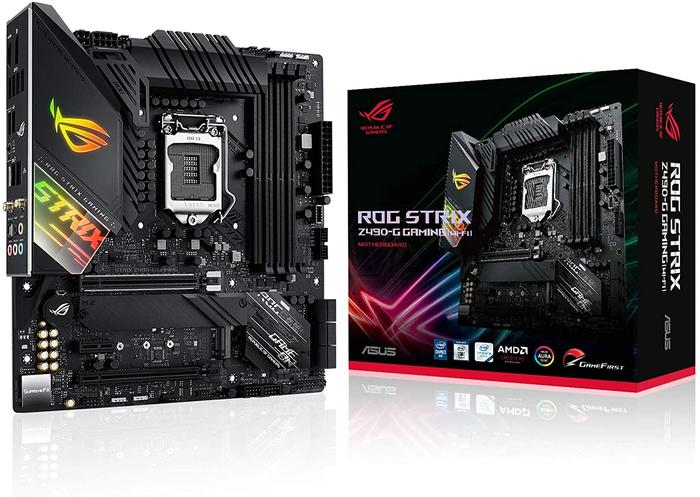
Key Specifications
- Chipset: Intel Z490
- Form Factor: Micro-ATX
- VRM: 12+2 Power Stages
- Memory: 4x DIMM, up to 128GB DDR4-4600 (OC)
- Storage: 2x M.2 slots, 6x SATA 6Gb/s ports
- Networking: Intel I225-V 2.5GbE LAN, Intel Wi-Fi 6 AX201
- Audio: ROG SupremeFX S1220A Codec
Objective Analysis
This motherboard brought high-end ROG features to the Micro-ATX vs Mini-ITX vs ATX debate. The ROG Strix Z490-G Gaming was ideal for users wanting a powerful, compact build without the size constraints of Mini-ITX. It featured a very capable 12+2 power stage VRM, which was impressive for its form factor and sufficient for the i9-10900K. It included premium features like 2.5GbE LAN, Wi-Fi 6, and a robust thermal solution, ensuring that performance was not compromised despite its smaller size.
Status & Alternatives
- Status: Discontinued.
- Alternatives: High-performance Micro-ATX boards are less common but still produced. Users looking for a modern equivalent could explore Z790 Micro-ATX offerings from ASUS’s ROG Strix or TUF Gaming lines, which continue to provide a balance of size and performance.
5. ASUS ROG Strix Z490-I Gaming
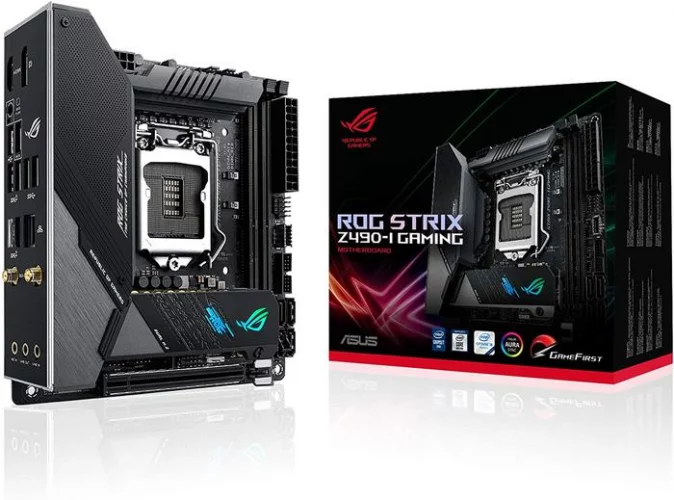
Key Specifications
- Chipset: Intel Z490
- Form Factor: Mini-ITX
- VRM: 8+2 Power Stages
- Memory: 2x DIMM, up to 64GB DDR4-4800 (OC)
- Storage: 2x M.2 slots, 4x SATA 6Gb/s ports
- Networking: Intel I225-V 2.5GbE LAN, Intel Wi-Fi 6 AX201
- Audio: ROG SupremeFX S1220A Codec
Objective Analysis
The ROG Strix Z490-I Gaming is a testament to packing immense power into a tiny footprint. As a Mini-ITX board, it was engineered for small form factor (SFF) builds without compromise. Despite its size, it boasted an 8+2 power stage VRM with active cooling, dual M.2 slots (one on the rear), and the same premium networking and audio found on its larger siblings. The engineering required to fit these features onto a 17×17 cm PCB is significant, making it a top choice for SFF enthusiasts.
Status & Alternatives
- Status: Discontinued.
- Alternatives: The market for high-end Mini-ITX motherboards remains strong. All major manufacturers offer flagship Z790 models in the Mini-ITX form factor, which are direct successors to the Z490-I and provide the latest platform features for compact, powerful builds.
6. MSI MEG Z490 ACE

Key Specifications
- Chipset: Intel Z490
- Form Factor: ATX
- VRM: 16+1 Power Stages (90A)
- Memory: 4x DIMM, up to 128GB DDR4-5000 (OC)
- Storage: 3x M.2 slots, 6x SATA 6Gb/s ports
- Networking: Realtek RTL8125B 2.5GbE, Intel I219V 1GbE, Intel Wi-Fi 6 AX201
- Audio: Realtek ALC1220 Codec + ESS SABRE9018Q2C DAC
Objective Analysis
Positioned just below the flagship GODLIKE model, the MSI MEG Z490 ACE offered a premium, enthusiast-grade experience. Its defining feature was its extremely robust 16+1 phase VRM with 90A power stages, designed for maximum overclocking stability. It also featured an excellent thermal solution with a Frozr heatsink and an actively cooled chipset. The inclusion of a high-fidelity ESS DAC made it a strong choice for users who prioritize audio quality. For anyone questioning how many PCIe slots they need, its three full-length slots offered ample expansion.
Status & Alternatives
- Status: Discontinued.
- Alternatives: This board has been succeeded by the ACE series on subsequent chipsets. A modern user would look towards the MSI MEG Z790 ACE, which continues the tradition of offering top-tier power delivery, extensive features, and premium build quality for the latest hardware.
7. GIGABYTE Z490 Vision D
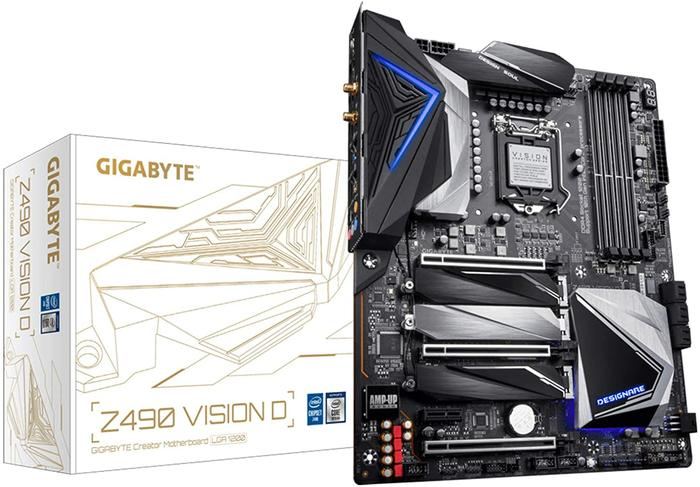
Key Specifications
- Chipset: Intel Z490
- Form Factor: ATX
- VRM: 12+1 Phases Direct Power Design (50A)
- Memory: 4x DIMM, up to 128GB DDR4-5000 (OC)
- Storage: 3x M.2 slots, 6x SATA 6Gb/s ports
- Networking: 2x Intel Gigabit LAN, Intel Wi-Fi 6 AX201
- Audio: Realtek ALC1220-VB Codec
Objective Analysis
The GIGABYTE Z490 Vision D targeted a different audience: content creators. Its most significant feature is the inclusion of two Thunderbolt 3 ports, offering 40 Gb/s of bandwidth for high-speed external storage and displays. While its 12+1 phase VRM is perfectly adequate for the i9-10900K, the focus is less on extreme overclocking and more on connectivity and stability. Its clean, silver-and-white aesthetic was also a deliberate choice to appeal to creative professionals using cases like the best white PC cases.
Status & Alternatives
- Status: Discontinued.
- Alternatives: GIGABYTE has continued its creator-focused “AERO” line (which succeeded the Vision series). A modern equivalent is the GIGABYTE Z790 AERO G, which offers updated features like DDR5, PCIe 5.0, and the latest Thunderbolt or USB4 ports.
8. GIGABYTE Z490 AORUS Xtreme
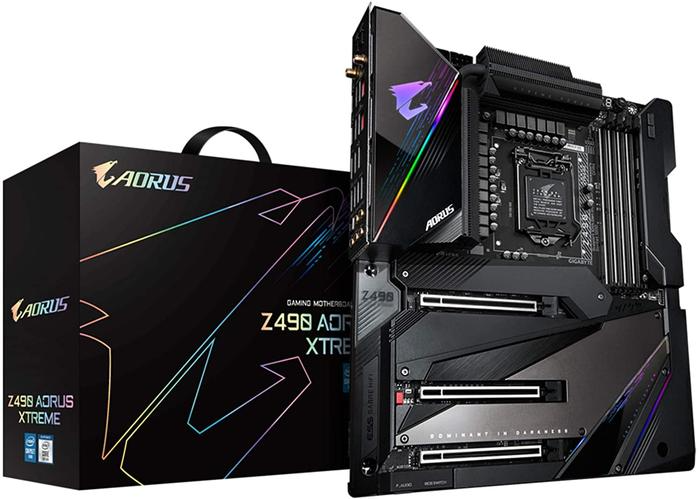
Key Specifications
- Chipset: Intel Z490
- Form Factor: E-ATX
- VRM: 16+1 Phases Digital Power Design (90A)
- Memory: 4x DIMM, up to 128GB DDR4-5000 (OC)
- Storage: 3x M.2 slots, 6x SATA 6Gb/s ports
- Networking: Aquantia 10GbE, Intel 2.5GbE LAN, Intel Wi-Fi 6 AX201
- Audio: Realtek ALC1220-VB Codec + ESS SABRE 9218 DAC
Objective Analysis
The Z490 AORUS Xtreme was GIGABYTE’s flagship motherboard, designed to be the ultimate platform for the i9-10900K. It is an E-ATX board packed with virtually every feature available at the time. Its 16-phase, 90A VRM and comprehensive thermal armor, which covers almost the entire PCB, were designed for elite-tier performance. Its networking was top-of-the-line, featuring both 10GbE and 2.5GbE LAN ports. The inclusion of Thunderbolt 3, a high-end ESS DAC, and extensive RGB made it a “no-compromise” solution for users with a large budget.
Status & Alternatives
- Status: Discontinued.
- Alternatives: This board was the pinnacle of the Z490 generation. Its direct successor would be the GIGABYTE Z790 AORUS Xtreme, which continues to serve as the brand’s top-tier platform, incorporating the latest technologies for users who want the absolute best.
User’s Guide for Selecting an i9-10900K Motherboard
If you are set on using the Intel Core i9-10900K, here is what you need to know to make an informed decision in the current market.
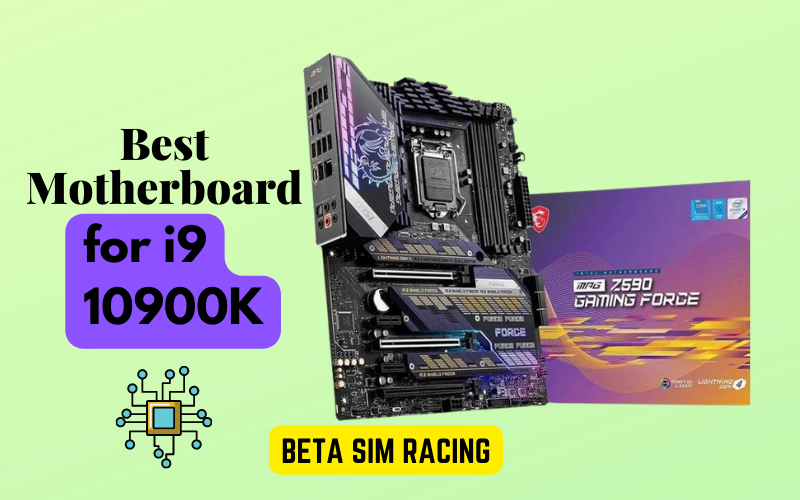
Understanding Chipset Differences: Z590 vs. Z490
Both Z490 and Z590 chipsets are compatible with the i9-10900K (though a Z490 board may require a BIOS update). The main advantage of the Z590 chipset was its support for PCIe 4.0, but this feature is only activated with an 11th Gen Intel CPU.
With an i9-10900K, a Z590 motherboard will function identically to a Z490 motherboard in terms of PCIe speed, operating at Gen 3.0. Therefore, there is no inherent performance benefit in choosing a Z590 over a Z490 for this specific CPU. Your decision should be based on the board’s specific features, condition, and price.
Critical Features for a 10th Gen Build
Voltage Regulator Module (VRM)
The i9-10900K is a power-hungry CPU, especially when overclocked. A robust VRM is crucial for stable performance. Look for motherboards with at least a 12+ phase power design and quality heatsinks over the VRM area to ensure adequate cooling.
Form Factor: ATX, Micro-ATX, and Mini-ITX
The size of your motherboard determines your case compatibility and expansion options.
- ATX: The standard size, offering the most PCIe slots and features.
- Micro-ATX: A smaller, more compact option that still offers good expansion.
- Mini-ITX: The smallest form factor, designed for compact builds with limited expansion.
Connectivity and Expansion
Consider your needs for USB ports, M.2 slots for fast NVMe storage, and networking. A board with 2.5GbE LAN and Wi-Fi 6 is a modern standard, even on these older platforms. If you’re unsure how many M.2 slots you have on a motherboard, it’s a key specification to check for storage expandability.
The Challenge of Sourcing LGA 1200 Motherboards Today
New LGA 1200 motherboards are no longer in mass production. Your primary sources will be:
- Used Marketplaces: Sites like eBay are the most likely place to find these models. Scrutinize listings for seller ratings and photos of the actual product, paying close attention to the CPU socket for any bent pins.
- New Old Stock (NOS): Some retailers may have lingering stock, but it will be rare and potentially expensive.
When buying used, be aware that you are unlikely to have a manufacturer’s warranty. It’s crucial to know how to test a motherboard upon arrival to ensure it is fully functional.
When to Consider a Modern CPU Platform
If you do not already own an i9-10900K, it is strongly advised to consider a current-generation platform (such as Intel’s LGA 1700 or AMD’s AM5). A modern CPU like an Intel Core i5-14600K paired with a Z790 motherboard can offer comparable or superior performance, especially in gaming, while also providing access to newer technologies like DDR5 memory, PCIe 5.0, and a full manufacturer warranty. Building on a current platform is significantly easier and often more cost-effective in the long run.
Frequently Asked Questions (FAQ)
Is the Intel i9-10900K still a good CPU for gaming?
Yes, the i9-10900K is still a very capable gaming CPU. Its high clock speeds and 10 cores can handle the vast majority of modern games at high frame rates, though it may not match the peak performance of the latest-generation flagship processors.
What is the primary difference between Z490 and Z590 motherboards for a 10900K?
For a 10900K user, the functional difference is minimal. The main feature of Z590, PCIe 4.0 support, is only enabled with an 11th Gen CPU. Other differences include native USB 3.2 Gen 2×2 support on Z590 and potentially improved memory overclocking on some Z590 models.
Can I use PCIe 4.0 devices with an i9-10900K on a Z590 motherboard?
Yes, you can use PCIe 4.0 devices like GPUs and SSDs, but they will operate at PCIe 3.0 speeds. The i9-10900K’s integrated PCIe controller is limited to Gen 3.0.
Are new LGA 1200 motherboards still being manufactured?
No, major manufacturers have ceased production of LGA 1200 motherboards. The market is now supplied by remaining new-old-stock and a much larger pool of used boards.
What is the maximum supported RAM speed for the i9-10900K?
The official JEDEC specification for the i9-10900K is DDR4-2933. However, with a Z490 or Z590 motherboard, you can enable XMP (Extreme Memory Profile) to use much faster overclocked RAM, with many boards supporting speeds well over 4000MHz.
Do I need to update the BIOS when installing an i9-10900K?
If you are using a Z490 motherboard, it will support the i9-10900K out of the box. If you are using a Z590 motherboard, it will also support the i9-10900K without needing an update, as it was designed to be backward compatible with 10th-gen processors.

Holding a Ph.D. in Computer Science, Dr. Alistair Finch is our chief PC Component Benchmark Analyst. He provides meticulous, data-driven analysis of CPUs and GPUs, moving beyond marketing claims to reveal their true performance. His guides help readers understand the intricate relationship between hardware architecture and real-world gaming frame rates.
